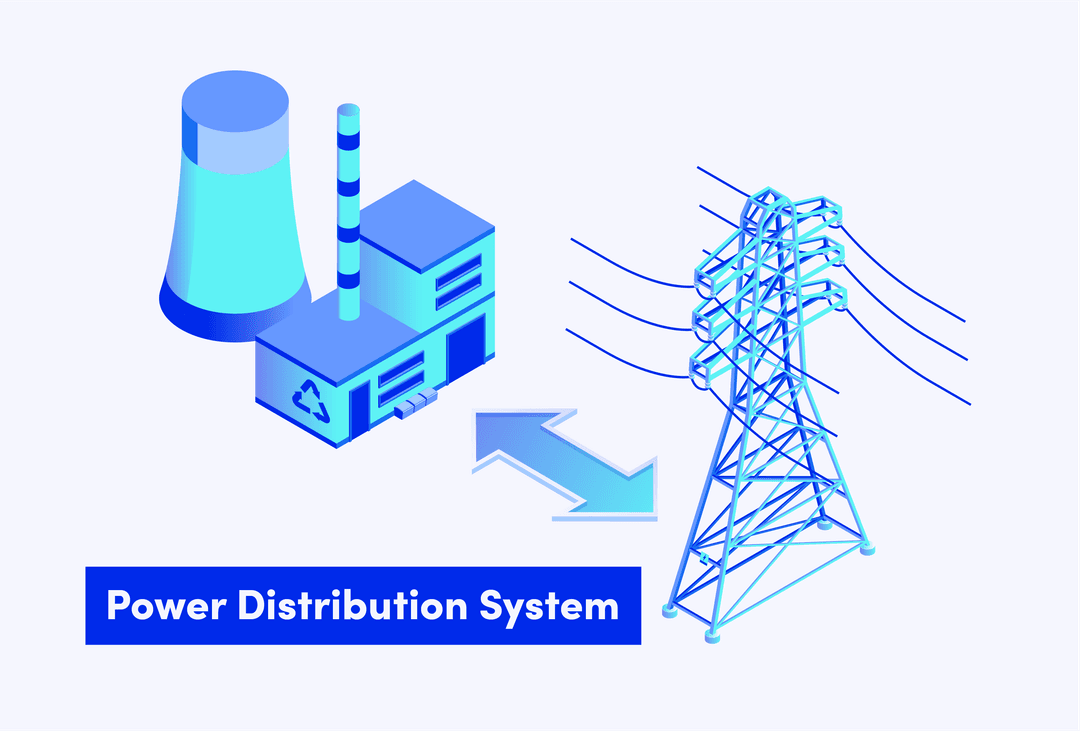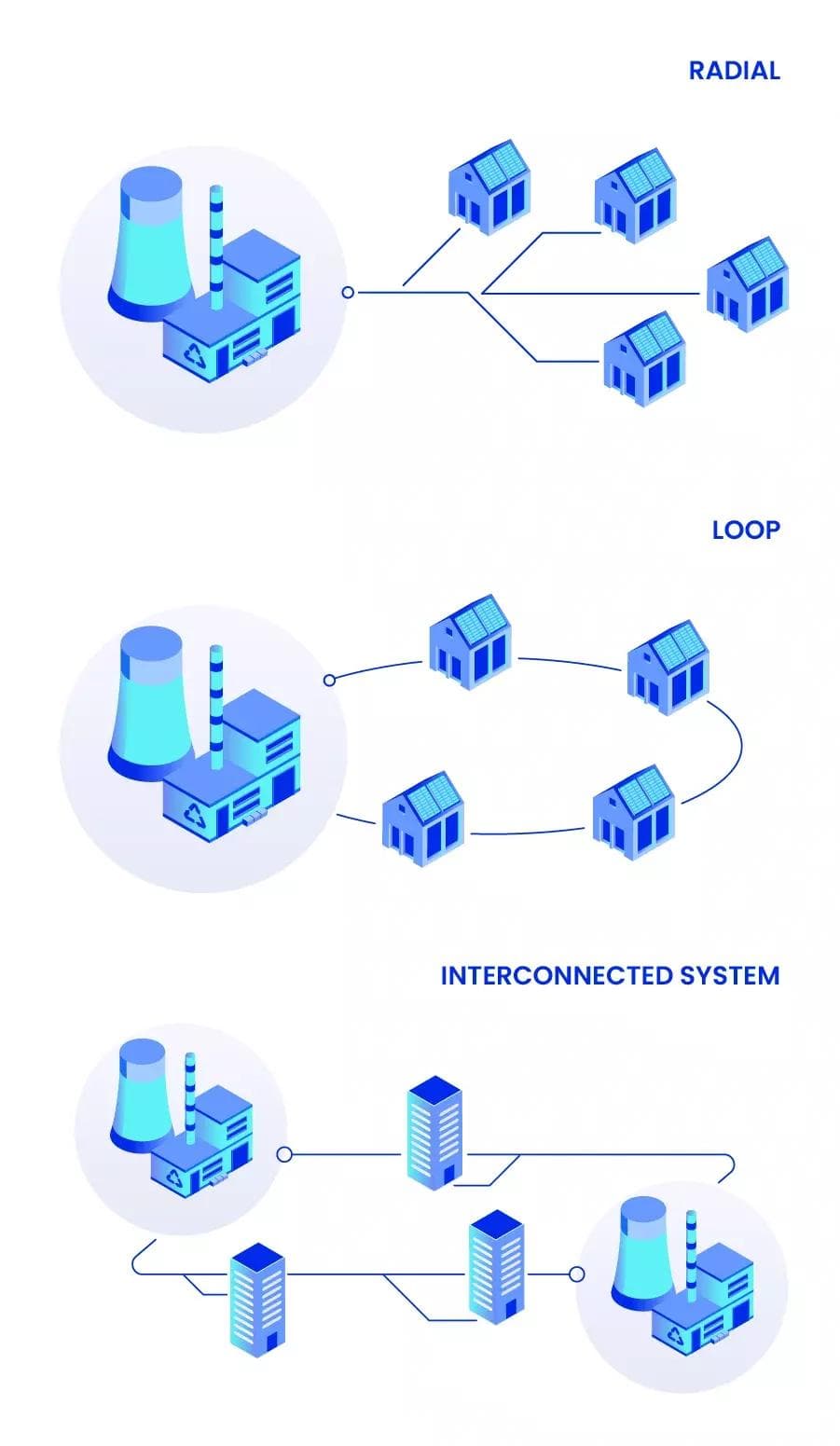Having touched upon the case of smart grids, microgrids, and how the grid’s capacity is being optimized by new technologies, we’re now staying in the broad topic of energy systems. Now, it’s time to take a closer look at it from a slightly different angle and focus on a specific part of the whole grid undertaking.
What is a power distribution network?
To understand it, it’d be useful to take a step back and look at the energy system as a whole. The global energy system is a vast and complex network that supplies energy to homes and businesses across the entire planet. It includes everything from power plants and transmission lines to distribution systems and end-use customers. Thus, four main branches may be distinguished:
- energy generation
- energy transmission
- energy distribution
- energy storage
The distribution may be deemed as the final stage in electric power delivery. It is responsible for carrying the electricity to the end-customers, i.e., households. For some, this description may get confusing with the grid itself, but it’s not quite interchangeable. To answer the question, how is that different from the grid, we must look at the power distribution network as a portion of the whole grid.
The power grid is the entire electrical system that transmits electricity from the generating plants to consumers. This includes high-voltage transmission lines and substations, as well as lower-voltage distribution lines and transformers. Power distribution network is a part of the grid owned or operated by a utility that is dedicated to delivering electric energy to customers and it refers specifically to the distribution system that carries electricity to individual customers. The grid also makes use of a top-down approach, with bulk electricity flowing from the power plant to consumers via transmission lines. The power distribution network, on the other hand, takes a more distributed approach, where smaller amounts of electricity are distributed from multiple sources within a local region
How does power distribution work?
The power distribution network is made up of a complex network of circuits, cables, transformers, poles, junction boxes, and other equipment that carries electricity from substations to homes and businesses.
Electrical power is distributed to individuals, commercial businesses, and industrial complexes through an intricate network of substations, transmission lines, and transformers. The process starts with electricity being transferred from the high voltage level of a major grid or station to local distribution substations, where it undergoes transformation into medium levels ranging between 2-35 kV via specialized equipment called transformers. From there, primary distribution takes effect, sending energy along designated routes until sectionalizing points are reached, reducing it further by transformer units for use in homes and businesses. The voltage fit for the domestic appliances is known as utilization voltages.
Customers can sometimes be supplied with electricity through a secondary distribution system, to which they are connected through service drops. For those who have larger demands for power - usually businesses or industrial operations - a direct connection can be made at higher voltage subtransmissions.
The technology behind power distribution
… or at least some of the most crucial appliances enabling the whole undertaking:
- Circuit breaker - an essential device that safeguards all electrical circuits from being overloaded or facing a potential fire hazard. They serve as important safety measures by automatically cutting the power flow in moments of increased current, protecting your equipment and wiring with every turn-off.
- Substation - crucial points on the distribution map that transform voltage from high to low (or vice versa) and enable the transfer of energy between transmission systems and the distribution networks, which then can bring it into homes.
- Service drop - (the nomenclature may change depending on the region) overhead electrical line that delivers power from the pole to any building or residence. This is the final stretch before electricity enters the building.
- Distribution transformers - they bridge the gap between large energy networks and individual households. Acting as integral nodes in the electric power grid, these devices are vital for providing electricity to homes and businesses by taking high voltage input from distribution lines and transforming it into a lower output that is safe for everyday use.
- Feeder - a backbone for electricity distribution, linking power from sub-stations to end-user locations
Types of power distribution networks
The distribution network can be classified under a few categories. The most common way to classify a network is by its design. Sometimes it’s also called “the method of connection”.
There are three main types of network designs that we can differentiate:
- loop
- radial
- interconnected network
Types of power distribution networks
Radial
With radial, a single feeder distributes electricity through one-way circuits directly onto distributors located across each designated area. The radial Distribution System is the most cost-effective option for supplying power in remotely located areas, and is fairly easy to implement. This type of system uses a single source to serve multiple customers, however, one disrupted line can cause an entire outage until repairs are completed, which makes it prone to malfunctions.
Loop
Looped power networks usually come with a back-up source of energy. When power from one direction fails, switches automatically or manually divert energy to keep electricity flowing in the other direction. The loop guarantees higher standards of reliability than the radial type. In the case of line faults, utilities can quickly locate them and switch around to restore service, enabling fast repair with minimal customer disruption.
Interconnected Network
Network systems offer a unique solution for customers needing reliable power in heavily populated and congested areas. This system consists of interlocking loop networks, providing multiple sources to deliver energy efficiently, though it comes with the highest price tag among all alternative options.
Other than design, power distribution networks can also be classified by the supply type or by the construction.
There are two types of supply that we can differentiate:
- AC distribution system
- DC distribution system
In terms of the construction, there are underground and overhead systems. The underground system is a much safer option than overhead cables. It does come with drawbacks, though - primarily its hefty initial cost. The overhead system is the most popular one, and despite being slightly less safe, it does come with higher levels of flexibility.


